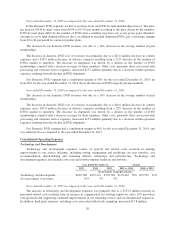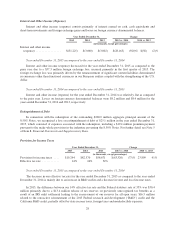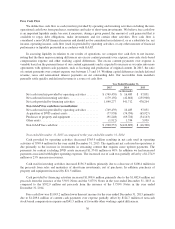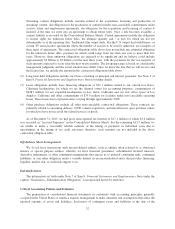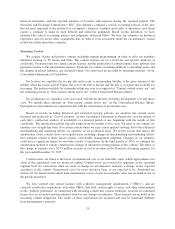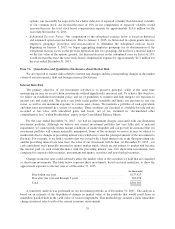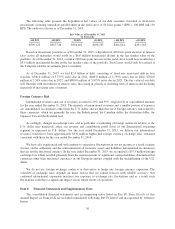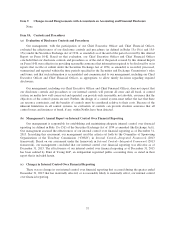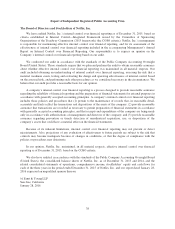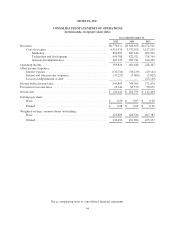NetFlix 2015 Annual Report Download - page 38
Download and view the complete annual report
Please find page 38 of the 2015 NetFlix annual report below. You can navigate through the pages in the report by either clicking on the pages listed below, or by using the keyword search tool below to find specific information within the annual report.Income Taxes
We record a provision for income taxes for the anticipated tax consequences of our reported results of
operations using the asset and liability method. Deferred income taxes are recognized by applying enacted
statutory tax rates applicable to future years to differences between the financial statement carrying amounts of
existing assets and liabilities and their respective tax bases as well as net operating loss and tax credit
carryforwards. The effect on deferred tax assets and liabilities of a change in tax rates is recognized in income in
the period that includes the enactment date. The measurement of deferred tax assets is reduced, if necessary, by a
valuation allowance for any tax benefits for which future realization is uncertain. There was no valuation
allowance as of December 31, 2015 or 2014.
Although we believe our assumptions, judgments and estimates are reasonable, changes in tax laws or our
interpretation of tax laws and the resolution of any tax audits could significantly impact the amounts provided for
income taxes in our consolidated financial statements.
In evaluating our ability to recover our deferred tax assets, in full or in part, we consider all available
positive and negative evidence, including our past operating results, and our forecast of future earnings, future
taxable income and prudent and feasible tax planning strategies. The assumptions utilized in determining future
taxable income require significant judgment and are consistent with the plans and estimates we are using to
manage the underlying businesses. Actual operating results in future years could differ from our current
assumptions, judgments and estimates. However, we believe that it is more likely than not that substantially all
deferred tax assets recorded on our Consolidated Balance Sheets will ultimately be realized. In the event we were
to determine that we would not be able to realize all or part of our net deferred tax assets in the future, an
adjustment to the deferred tax assets would be charged to earnings in the period in which we make such
determination.
We did not recognize certain tax benefits from uncertain tax positions within the provision for income taxes.
We may recognize a tax benefit only if it is more likely than not the tax position will be sustained on examination
by the taxing authorities, based on the technical merits of the position. The tax benefits recognized in the
financial statements from such positions are then measured based on the largest benefit that has a greater than
50% likelihood of being realized upon settlement. At December 31, 2015, our estimated gross unrecognized tax
benefits were $17.1 million of which $13.5 million, if recognized, would favorably impact our future earnings.
Due to uncertainties in any tax audit outcome, our estimates of the ultimate settlement of our unrecognized tax
positions may change and the actual tax benefits may differ significantly from the estimates. See Note 10 of
Item 8, Financial Statements and Supplementary Data for further information regarding income taxes.
Stock-Based Compensation
We grant fully vested non-qualified stock options to our employees on a monthly basis. As a result of
immediate vesting, stock-based compensation expense is fully recognized on the grant date, and no estimate is
required for post-vesting option forfeitures. Stock-based compensation expense at the grant date is based on the
total number of options granted and an estimate of the fair value of the awards.
We calculate the fair value of our stock option grants using a lattice-binomial model. This model requires
the input of highly subjective assumptions. Changes in the subjective input assumptions can materially affect the
estimate of fair value of options granted and our results of operations could be impacted.
•Expected Volatility: Prior to January 1, 2015, our computation of expected volatility was based on a
blend of historical volatility of our common stock and implied volatility of tradable forward call options
to purchase shares of our common stock, as low trade volume of our tradable forward call options prior
to 2011 precluded sole reliance on implied volatility. Beginning on January 1, 2015, expected volatility is
based solely on implied volatility. We believe that implied volatility of publicly traded options in our
common stock is more reflective of market conditions and, given consistently high trade volumes of the
34




